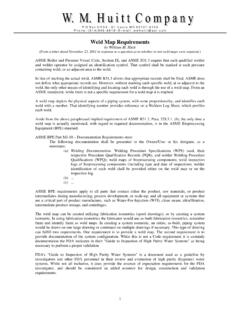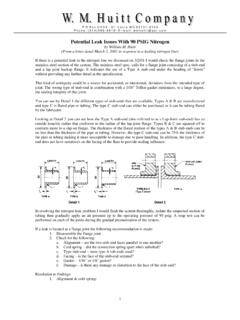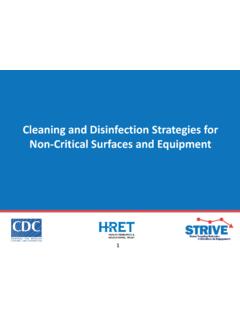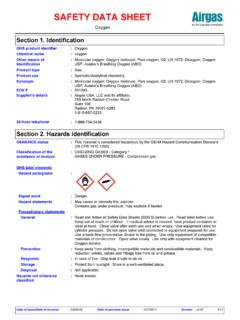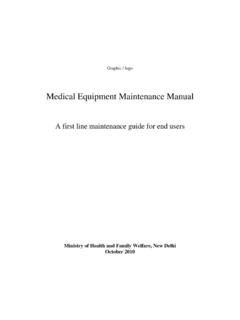Transcription of Material Selection for Gaseous Oxygen Service
1 P O B o x 3 11 5 4 S t . L o u i s, M O 6 3 1 3 1 - 0 1 5 4 P h o n e : ( 3 1 4 ) 9 6 6 - 8 9 1 9 ~ E m a i l : w m h u i t t @ a o l . c o m 1 Material Selection for Gaseous Oxygen Service by William M. Huitt (From a letter dated March 7, 2001 in response to a project s need to select tubing Material for Oxygen Service .) In selecting a pipe or tubing Material for Gaseous Oxygen Service there are four basic criteria: % Oxygen in the gas, pressure, temperature and velocity. As you can see by Fig. 1, if the system operates below 200 psig at 200 F then carbon steel or stainless steel would be suitable Material at almost any velocity. However, above those markers velocity becomes an issue and the Material Selection narrows. Figure 1 Maximum velocity versus internal pressure for steel pipelines ( mole% or higher Oxygen ) (Griffith and Wallis, Journal of Heat Transfer, August 1961) If a system is operating in a range above the curve in Fig.
2 1 copper tubing should be selected. This applies also in flow through valves, where velocity could be an issue, and also where Oxygen gas impinges directly on ferrous piping. Where velocity of flow through a valve may approach sonic velocity copper based materials will be required. Where direct impingement on ferrous piping occurs, velocity should be reduced to one-half the values of Fig. 1 or the impingement surface must be a copper based alloy. One major factor when selecting Material for Oxygen Service is the Material 's Melting Point Burn Ratio (BRmp). This is defined in ASTM G94 as follows: Numerous metals burn essentially in the molten state. Therefore, combustion of the metal must be able to produce melting of the metal itself. The BRmp is a ratio of the heat released during combustion of a metal to the heat required to both warm the metal to its melting point and provide the latent heat of fusion.
3 It is further defined by: BRmp = Hcombustion/( Hrt-mp + Hfusion) Where: H = heat of combustion Hrt-mp = heat required to warm the metal from room temperature (rt) to the melting point (mp) Hfusion = latent heat of fusion 200 400 600 800 1000 200 150 100 50 0 Internal Pressure, PSIG Maximum Allowable Velocity Ft/Sec (at line conditions) Carbon steel, stainless steel pipeline system at 200 F gas temperature (Max.) 2 Clearly, a metal that does not contain sufficient heat to melt itself (that is, one that has a BRmp <1) is severely impeded from burning in the molten state. Table 1 Calculated Melting-Point Burn RatiosA Material BRmp Silver Copper 90-10 copper-nickelB CDA 938 tin bronzeB CDA 314 leaded commercial bronzeB Monel 400B Cobalt Monel K500B Nickel CDA 828 beryllium copperB AISI 4140 low alloy steelB Ductile iron Cast iron AISI 1025 carbon steelB Iron 17-4 PHB 410 SSB CA 15 stainless steelB (see A296) 304 stainless steelB Titanium Lead Zinc Lead babbitB Magnesium Aluminum Tin BabbitB Tin A From Monroe, Bates & Pears, Flammability and Sensitivity of Materials in Oxygen B Presented for comparison only.
4 Alloys may exhibit flammability vastly inconsistent with the BRmp ranking. I provided table 1 so you can see the hierarchy of metals as it pertains to their Burn Ratios. As you can see, the carbon steels, stainless steels and coppers have the lower, more acceptable Burn Ratios, with copper being the lowest of those three. In the event flame propagation does occur, due to some ignition mechanism, those metals will tend to impede combustion of the metals themselves. The same results is indicated in ASTM G94, Table Promoted Combustion Test results, where combustion tests were carried out in mole% Oxygen . Copper had a Non-Propagation rate at 1000, 5000 & 8000 psig. 316 stainless steel had a Non-Propagation rate at 500 psig and various declared burn rates from 1000 to 10000 psig. Ductile iron (closest example of carbon steel) had a burn rate of in/sec at 500 psig (the lowest pressure these tests were performed at).
5 cleaning The tubing, as you know, requires cleaning per ASTM G93 and G127 in order to ensure removal of any foreign surface matter that could auto-ignite, or could ignite from impact during normal operation. This can be accomplished both on an individual random length basis by the manufacturer, and at the job site on a final installed system basis. Whether or not the pipe or tubing is suitably cleaned by the manufacturer, it should be capped prior to shipment and remain so until fabricated. Fabrication should be done in a controlled environment, capping or concealing all openings when not being worked. After fabrication, all openings should remain capped. Finished fabricated pieces should be stored in a clean dry area away from construction pathways and activities. 3 Summary In operating conditions at or below 200 F and 200 psig Type K copper tubing, or 316 SS tubing or pipe would be acceptable.
6 Above those operating conditions Type K copper would be acceptable. Tubing should be purchased in a pre-cleaned condition with a final cleaning performed after installation. Joints can be brazed copper, compression fittings, buttweld or flanged. In an effort to minimize recessed areas that may be difficult to clean, and provide areas for foreign particles to hide, minimize the number of joints in a system. Use flange joints only when required at equipment . When compression fittings are used, make certain the tube is fully bottomed out in the fitting body before pull-up. Quarter-turn, quick opening valves are not recommended. Reference Codes Codes and guidelines pertaining to Oxygen and Oxygen Systems: ASTM: G63 Standard Guide for Evaluating non-metallics for Oxygen Service G72 Autogenous Ignition Temperature of Liquids and Solids in High-Pressure Oxygen Enriched Environment G74 Ignition Sensitivity of Materials to Gaseous Fluid Impact G86 Ignition Sensitivity of Materials to Mechanical Impact in Pressurized Oxygen G88 Standard Guide for Designing Systems for Oxygen Service G93 cleaning Methods for Materials & equipment Used in Oxygen Enriched Environment G94 Evaluating Metals for Oxygen Service G126 Standard Terminology Relating to the Compatibility and Sensitivity of Materials in Oxygen Enriched Atmospheres G127 Standard Guide for the Selection of cleaning Agents for Oxygen Systems D2863 Measuring the Minimum Oxygen Concentration to Support Candle Like Combustion of Plastics/ Oxygen Index F1792 Standard Specification for Special Requirements
7 For Valves Used in Gaseous Oxygen Service CGA: AV-8 Characteristics and Safe Handling of Cryogenics Liquid and Gaseous Oxygen G-4 Oxygen cleaning equipment for Oxygen Service Industrial Practices for Gaseous Oxygen Transmission & Distribution Piping Systems O2-DIR 2000 Directory of cleaning Agents for Oxygen Service NFPA: 53M Fire Hazards in Oxygen Enriched Atmospheres END OF LETTER

